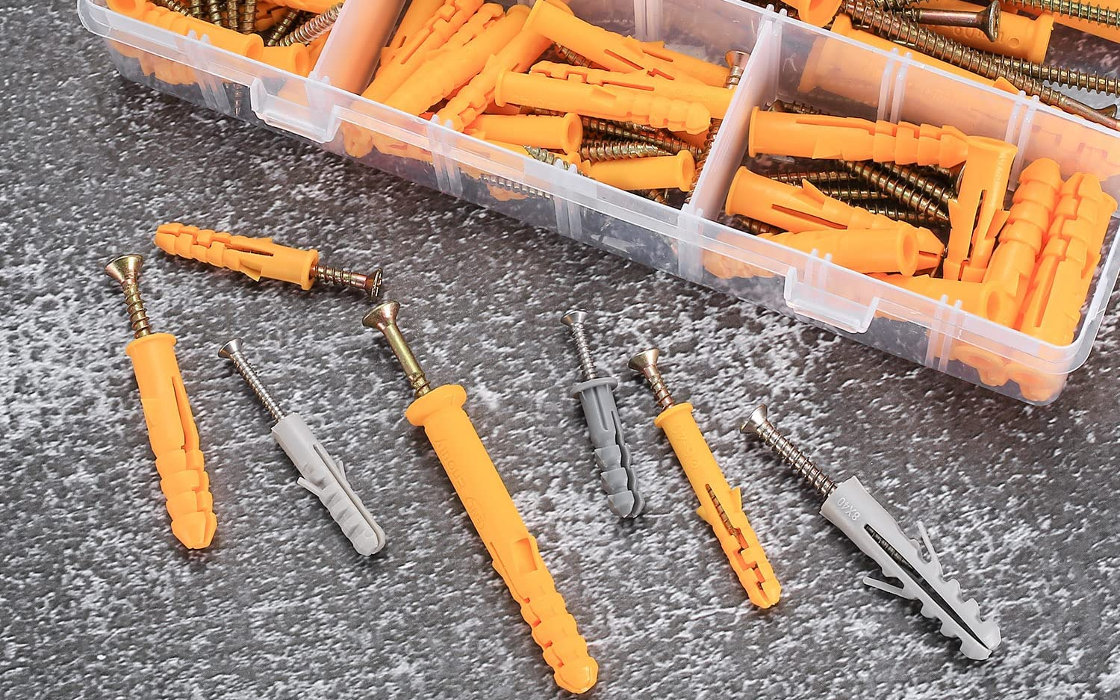Wall plugs are a brilliantly simple and familiar bit of DIY equipment. When used correctly, they ensure screws grip firmly into materials such as masonry, plaster, and brick.
If the surface is solid and sound, drilling a hole, inserting a wall plug, and tightening the screw should go without a problem. Unfortunately, not all surfaces you might need to drill will be in good condition. And a loose wall plug is almost as bad as no wall plug.
No matter if the wall has crumbled around the drill bit as you were drilling the hole, or if an existing wall plug has loosened over time, there are ways to fix it.
1. Use a Bigger Wall Plug
If the diameter of the hole has spread as you drilled it, you can try using a slightly larger wall plug. You will also need to use a larger screw, as the original one you planned to use might not grip the inside of the larger plug properly.
If using a larger screw is not an option, perhaps because the fixture you will be using has pre-drilled holes or hangers, this method might still work. Try the original screw in the larger wall plug to test if it will grip when screwed in. If it is too loose, insert a thin sliver of wood/toothpick into the wall plug before screwing in the screw.

2. Fill the Hole and Start Again
If there is a lot of crumbling around the hole as you drill, it could be a sign that the whole wall is in bad condition. Or it could be an isolated patch of loose plaster, mortar or a crack in a brick.
- Use the drill to spread the hole a little more, so it is at least twice the width you need.
- Use a good quality quick-drying filler to fill the hole, and smooth it out at the wall surface.
- Let the filler dry completely, following the manufacturer’s instructions.
- Measure, mark and drill the hole again. Hopefully, this will be in the middle of the dry and hardened filler patch.
The filler should soak slightly into the surrounding wall material and make it firmer. And the dry filler will be easy to drill accurately for the wall plug.
You can also use filler when the plug is only slightly loose in the hole. Remove the wall plug, squeeze a small amount of filler into the entrance to the hole, and push the wall plug in until it is flush. The filler will be compressed around the plug, making it a solid fixing when it dries.
3. Pack Out the Gap Around the Wall Plug
Before plastic or nylon wall plugs were commonly available, wood splinters or match sticks were often used in their place. The wood gives the screw thread something to grip and spreads outwards to grip the inside of the hole.
We aren’t suggesting you replace wall plugs with matchsticks, but you can use packing to make a loose plug fit more tightly.
- Depending on the size of the gap, insert one or more thin pieces of wood into the hole and push the wall plug in to hold them in place.
- Snap off the wood at the wall surface, and then carefully hammer the plug into place.
- If you don’t have small pieces of wood, you can use short lengths of copper wire (the type with plastic sheathing), or split another wall plug in half, lengthways, and use the two halves to pack out the gap.
4. Use a Wet N Fix Disc
If you aren’t familiar with Wet N Fix discs, they are small discs of fabric embedded with water-activated adhesive powder. They act as both packing around the wall plug and as an adhesive to create a solid fit.
- You immerse a single disc in water and shake off any excess.
- Place the end of the wall plug in the centre of the disc and mould it around the sides.
- Push the wall plug into the hole in a twisting motion until it is flush with the wall.
- It should feel fairly tight and will get firmer as the adhesive sets. But if there is still a lot of movement, add a second Wet N Fix disc to the plug.
Wet N Fix discs are a great solution to loose wall plugs. They are like a combination of all of the methods explored above. And potentially better than any of them. They last a long time in their packaging if kept away from moisture, so keeping a pack in your toolkit is a great idea.
When drilling through plasterboard, the hole crumbling is not usually a problem. Getting a strong, solid fixing can be. It is important to use the correct plasterboard fixings if you want long-lasting results.
Fixing a Loose Wall Plug
A drilled hole that is a bit big, or a wall plug and screw coming loose are common problems. Making sure the wall plug, screw and fixture are solid again is not difficult. You just need to choose the solution that works best for the situation.







